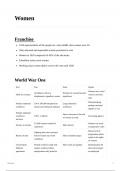Women
Franchise
1918 representation of the people act- only middle class women over 30
Only educated and repeatable women promoted to vote
Women in 1918 comprised of 43% of the electorate
8.4million voters were women
Working class women didn’t receive the vote until 1928
World War One
Fact Stat Point Impact
Women now could
Auxillaries, drivers, Position of women became
Work for women work for the first
telephonists, signallers, nurses significant
time
Demonstrating
Female industrial 1914- 200,000 employed in Large industrial
perhaps minimal
workforce metals and chemicals industry workforce.
impact of war
Female industrial
Shows increase in the role
workforce 1918- 1 million Increasing agency
of women in work
increase
11,000 women worked in Women can work
Factory in Gretna Main factory
explosives in imperative roles
Shows lack of
Fighting men who returned
progression (short
Return of men forced women out of the Shows limited impact
term) in the rights
workplace
of women
Government Female workers could only Shows lack of equality Demonstrates the
Dilution replace workers if their short term impact
agreement employment only lasted as as employed
Women 1
, long as the way and they women returned to
would receive less wage 1914 levels
Level of
employed women
5.7million
returned to 1914
levels
Working class
Shows lack of job
women Being a maid, cook or cleaner Shows disparity in class
prospects
employment
Shows
The work they did was
dissatisfaction with
1918 how many highly unpopular they
quality of life and
women were in 1.25million were keen to find other
lack of job
service unemployment | labelled
opportunities,
as ‘womens work’
segregation
Shows class
Factory or service discrepencies
Working class women Clerical work if educated
work between the
gender.
Clerical was
biggest growth
1 million employed as typists Shows long term
area for female Further 300,000 in 1931
or clerks in 1921 positivity
employment in
20s
Desperation due to
Sweated labour
Main method of employment unemployment benefit rate
and light
for those desperate being set lower for women
manufacturing
than for men
Provided greater
Sex Removed the bar of a opportunities but
disqualification 1919 woman from a career in male attitude
act law or civil service majority
unchanged
3,000 female
medical In 1931 Low number
practitioners
Shows disparity in
180,000 nurses In 1931
superior roles achieved
21 female Out of 6,000 In 1931 Shows superficial
architects change of the sex
Women 2





